ESP FIAT 124 SPIDER 2020 Owner handbook (in English)
[x] Cancel search | Manufacturer: FIAT, Model Year: 2020, Model line: 124 SPIDER, Model: FIAT 124 SPIDER 2020Pages: 228, PDF Size: 5.08 MB
Page 78 of 228
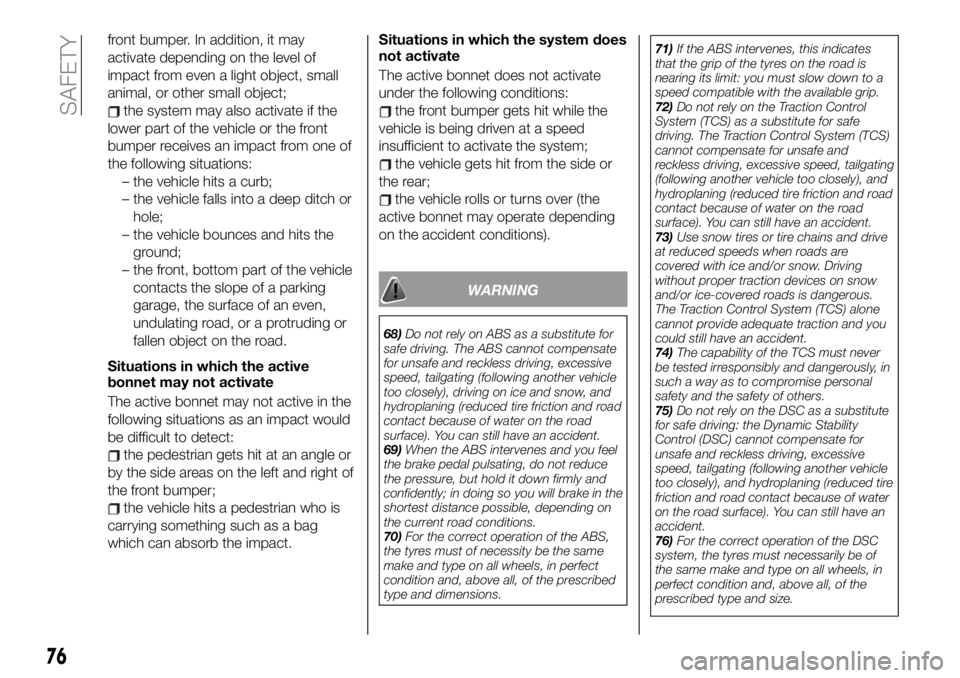
front bumper. In addition, it may
activate depending on the level of
impact from even a light object, small
animal, or other small object;
the system may also activate if the
lower part of the vehicle or the front
bumper receives an impact from one of
the following situations:
– the vehicle hits a curb;
– the vehicle falls into a deep ditch or
hole;
– the vehicle bounces and hits the
ground;
– the front, bottom part of the vehicle
contacts the slope of a parking
garage, the surface of an even,
undulating road, or a protruding or
fallen object on the road.
Situations in which the active
bonnet may not activate
The active bonnet may not active in the
following situations as an impact would
be difficult to detect:
the pedestrian gets hit at an angle or
by the side areas on the left and right of
the front bumper;
the vehicle hits a pedestrian who is
carrying something such as a bag
which can absorb the impact.Situations in which the system does
not activate
The active bonnet does not activate
under the following conditions:
the front bumper gets hit while the
vehicle is being driven at a speed
insufficient to activate the system;
the vehicle gets hit from the side or
the rear;
the vehicle rolls or turns over (the
active bonnet may operate depending
on the accident conditions).
WARNING
68)Do not rely on ABS as a substitute for
safe driving. The ABS cannot compensate
for unsafe and reckless driving, excessive
speed, tailgating (following another vehicle
too closely), driving on ice and snow, and
hydroplaning (reduced tire friction and road
contact because of water on the road
surface). You can still have an accident.
69)When the ABS intervenes and you feel
the brake pedal pulsating, do not reduce
the pressure, but hold it down firmly and
confidently; in doing so you will brake in the
shortest distance possible, depending on
the current road conditions.
70)For the correct operation of the ABS,
the tyres must of necessity be the same
make and type on all wheels, in perfect
condition and, above all, of the prescribed
type and dimensions.71)If the ABS intervenes, this indicates
that the grip of the tyres on the road is
nearing its limit: you must slow down to a
speed compatible with the available grip.
72)Do not rely on the Traction Control
System (TCS) as a substitute for safe
driving. The Traction Control System (TCS)
cannot compensate for unsafe and
reckless driving, excessive speed, tailgating
(following another vehicle too closely), and
hydroplaning (reduced tire friction and road
contact because of water on the road
surface). You can still have an accident.
73)Use snow tires or tire chains and drive
at reduced speeds when roads are
covered with ice and/or snow. Driving
without proper traction devices on snow
and/or ice-covered roads is dangerous.
The Traction Control System (TCS) alone
cannot provide adequate traction and you
could still have an accident.
74)The capability of the TCS must never
be tested irresponsibly and dangerously, in
such a way as to compromise personal
safety and the safety of others.
75)Do not rely on the DSC as a substitute
for safe driving: the Dynamic Stability
Control (DSC) cannot compensate for
unsafe and reckless driving, excessive
speed, tailgating (following another vehicle
too closely), and hydroplaning (reduced tire
friction and road contact because of water
on the road surface). You can still have an
accident.
76)For the correct operation of the DSC
system, the tyres must necessarily be of
the same make and type on all wheels, in
perfect condition and, above all, of the
prescribed type and size.
76
SAFETY
Page 79 of 228

77)The capability of the DSC system must
never be tested irresponsibly and
dangerously, in such a way as to
compromise personal safety and the safety
of others.
78)If the active bonnet has activated,
always contact a Fiat Dealership. If the
bonnet release handle is pulled after the
active bonnet has activated, the bonnet will
rise even further. If the vehicle is driven with
the bonnet raised it will obstruct visibility
and could result in an accident. In addition,
do not attempt to push the bonnet back
down. Otherwise, it could deform the
bonnet or cause injury because the
activated bonnet cannot be lowered
manually. Before driving the vehicle contact
a Fiat Dealership after the active bonnet
has activated, make sure that the raised
bonnet does not obstruct vision and drive
the vehicle at a low speed.AUXILIARY DRIVING
SYSTEMS
TPMS (Tire Pressure
Monitoring System)
79) 80) 81)
The Tire Pressure Monitoring System
(TPMS) monitors the air pressure of all
four tires. If the air pressure of one or
more tires is too low, the system warns
the driver by indicating the tire pressure
monitoring system warning light
in
the instrument cluster and operating a
beep sound. The system monitors the
tire pressures indirectly using the data
sent from the ABS wheel speed
sensors.
To allow the system to operate
correctly, the system needs to be
initialized with the specified tire pressure
(value on the tire pressure label). Refer
to “Tire Pressure Monitoring System
Initialization” in this paragraph.
The warning light flashes when the
system has a malfunction. Refer to
“Warning lights and messages”
paragraph in “Knowing the instrument
panel” chapter.
IMPORTANT Each tire, including the
spare (where provided), should be
checked monthly when cold and
inflated to the inflation pressure
recommended by the vehiclemanufacturer on the vehicle placard or
tire inflation pressure label (if your
vehicle has tires of a different size than
the size indicated on the vehicle placard
or tire inflation pressure label, you
should determine the proper tire
inflation pressure for those tires).
IMPORTANT As an added safety
feature, your vehicle has been equipped
with a TPMS system that illuminates a
low tire pressure telltale when one or
more of your tires is significantly
under-inflated. Accordingly, when the
low tire pressure telltale illuminates, you
should stop and check your tires as
soon as possible, and inflate them to
the proper pressure. Driving on a
significantly under-inflated tire causes
the tire to overheat and can lead to tire
failure. Under-inflation also reduces fuel
efficiency and tire tread life, and may
affect the vehicle's handling and
stopping ability.
IMPORTANT Please note that the
TPMS is not a substitute for proper tire
maintenance, and it is the driver's
responsibility to maintain correct tire
pressure, even if under-inflation has not
reached the level to trigger illumination
of the TPMS low tire pressure telltale.
Your vehicle has also been equipped
with a TPMS malfunction indicator to
77
Page 80 of 228
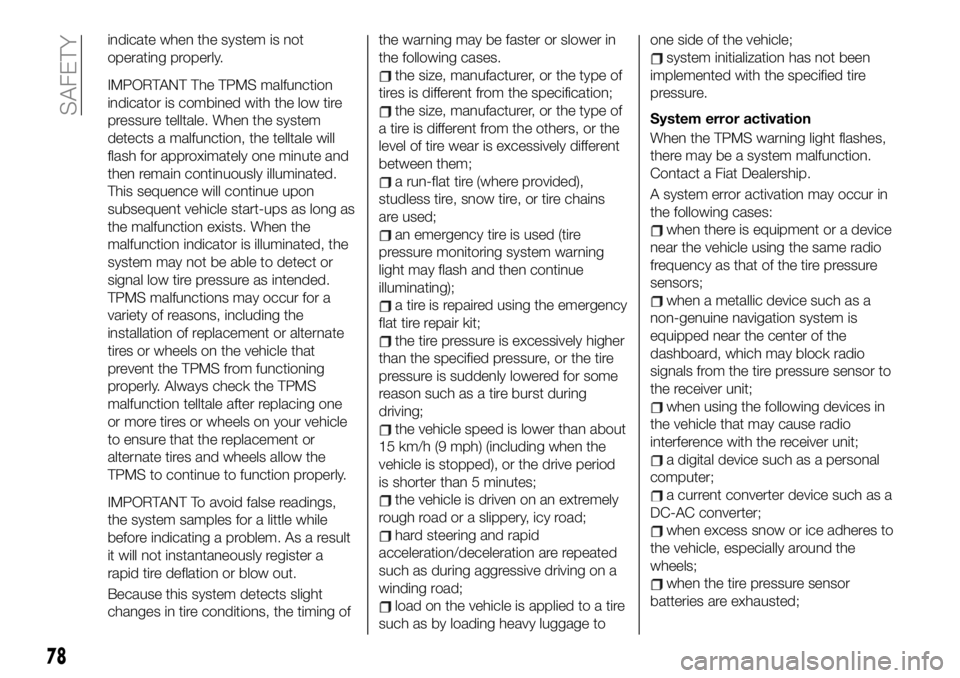
indicate when the system is not
operating properly.
IMPORTANT The TPMS malfunction
indicator is combined with the low tire
pressure telltale. When the system
detects a malfunction, the telltale will
flash for approximately one minute and
then remain continuously illuminated.
This sequence will continue upon
subsequent vehicle start-ups as long as
the malfunction exists. When the
malfunction indicator is illuminated, the
system may not be able to detect or
signal low tire pressure as intended.
TPMS malfunctions may occur for a
variety of reasons, including the
installation of replacement or alternate
tires or wheels on the vehicle that
prevent the TPMS from functioning
properly. Always check the TPMS
malfunction telltale after replacing one
or more tires or wheels on your vehicle
to ensure that the replacement or
alternate tires and wheels allow the
TPMS to continue to function properly.
IMPORTANT To avoid false readings,
the system samples for a little while
before indicating a problem. As a result
it will not instantaneously register a
rapid tire deflation or blow out.
Because this system detects slight
changes in tire conditions, the timing ofthe warning may be faster or slower in
the following cases.
the size, manufacturer, or the type of
tires is different from the specification;
the size, manufacturer, or the type of
a tire is different from the others, or the
level of tire wear is excessively different
between them;
a run-flat tire (where provided),
studless tire, snow tire, or tire chains
are used;
an emergency tire is used (tire
pressure monitoring system warning
light may flash and then continue
illuminating);
a tire is repaired using the emergency
flat tire repair kit;
the tire pressure is excessively higher
than the specified pressure, or the tire
pressure is suddenly lowered for some
reason such as a tire burst during
driving;
the vehicle speed is lower than about
15 km/h (9 mph) (including when the
vehicle is stopped), or the drive period
is shorter than 5 minutes;
the vehicle is driven on an extremely
rough road or a slippery, icy road;
hard steering and rapid
acceleration/deceleration are repeated
such as during aggressive driving on a
winding road;
load on the vehicle is applied to a tire
such as by loading heavy luggage toone side of the vehicle;
system initialization has not been
implemented with the specified tire
pressure.
System error activation
When the TPMS warning light flashes,
there may be a system malfunction.
Contact a Fiat Dealership.
A system error activation may occur in
the following cases:
when there is equipment or a device
near the vehicle using the same radio
frequency as that of the tire pressure
sensors;
when a metallic device such as a
non-genuine navigation system is
equipped near the center of the
dashboard, which may block radio
signals from the tire pressure sensor to
the receiver unit;
when using the following devices in
the vehicle that may cause radio
interference with the receiver unit;
a digital device such as a personal
computer;
a current converter device such as a
DC-AC converter;
when excess snow or ice adheres to
the vehicle, especially around the
wheels;
when the tire pressure sensor
batteries are exhausted;
78
SAFETY
Page 98 of 228
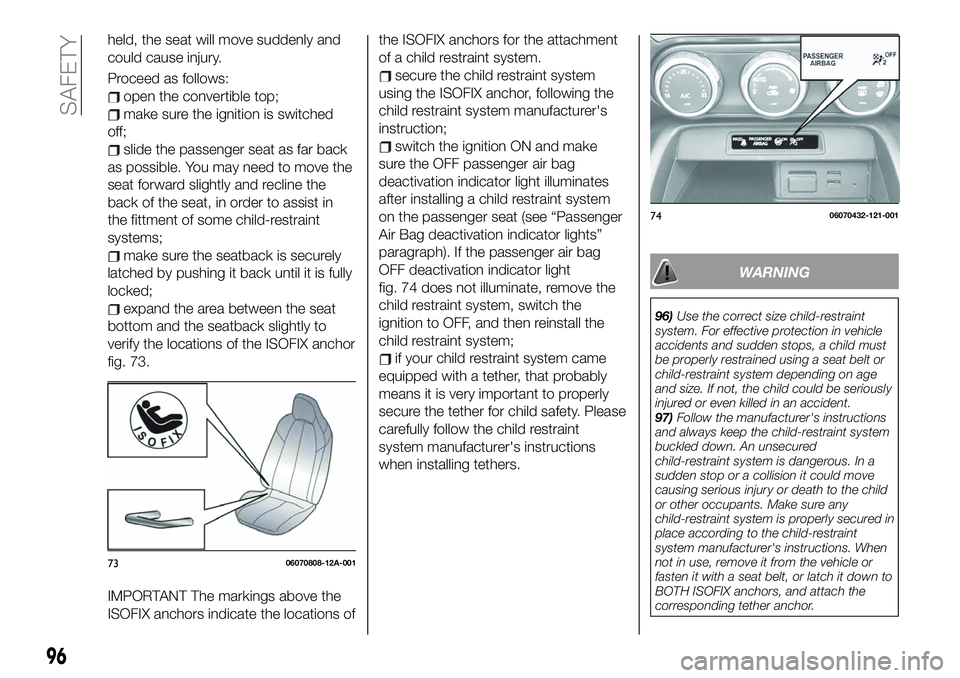
held, the seat will move suddenly and
could cause injury.
Proceed as follows:
open the convertible top;
make sure the ignition is switched
off;
slide the passenger seat as far back
as possible. You may need to move the
seat forward slightly and recline the
back of the seat, in order to assist in
the fittment of some child-restraint
systems;
make sure the seatback is securely
latched by pushing it back until it is fully
locked;
expand the area between the seat
bottom and the seatback slightly to
verify the locations of the ISOFIX anchor
fig. 73.
IMPORTANT The markings above the
ISOFIX anchors indicate the locations ofthe ISOFIX anchors for the attachment
of a child restraint system.
secure the child restraint system
using the ISOFIX anchor, following the
child restraint system manufacturer's
instruction;
switch the ignition ON and make
sure the OFF passenger air bag
deactivation indicator light illuminates
after installing a child restraint system
on the passenger seat (see “Passenger
Air Bag deactivation indicator lights”
paragraph). If the passenger air bag
OFF deactivation indicator light
fig. 74 does not illuminate, remove the
child restraint system, switch the
ignition to OFF, and then reinstall the
child restraint system;
if your child restraint system came
equipped with a tether, that probably
means it is very important to properly
secure the tether for child safety. Please
carefully follow the child restraint
system manufacturer's instructions
when installing tethers.
WARNING
96)Use the correct size child-restraint
system. For effective protection in vehicle
accidents and sudden stops, a child must
be properly restrained using a seat belt or
child-restraint system depending on age
and size. If not, the child could be seriously
injured or even killed in an accident.
97)Follow the manufacturer's instructions
and always keep the child-restraint system
buckled down. An unsecured
child-restraint system is dangerous. In a
sudden stop or a collision it could move
causing serious injury or death to the child
or other occupants. Make sure any
child-restraint system is properly secured in
place according to the child-restraint
system manufacturer's instructions. When
not in use, remove it from the vehicle or
fasten it with a seat belt, or latch it down to
BOTH ISOFIX anchors, and attach the
corresponding tether anchor.
7306070808-12A-001
7406070432-121-001
96
SAFETY
Page 129 of 228
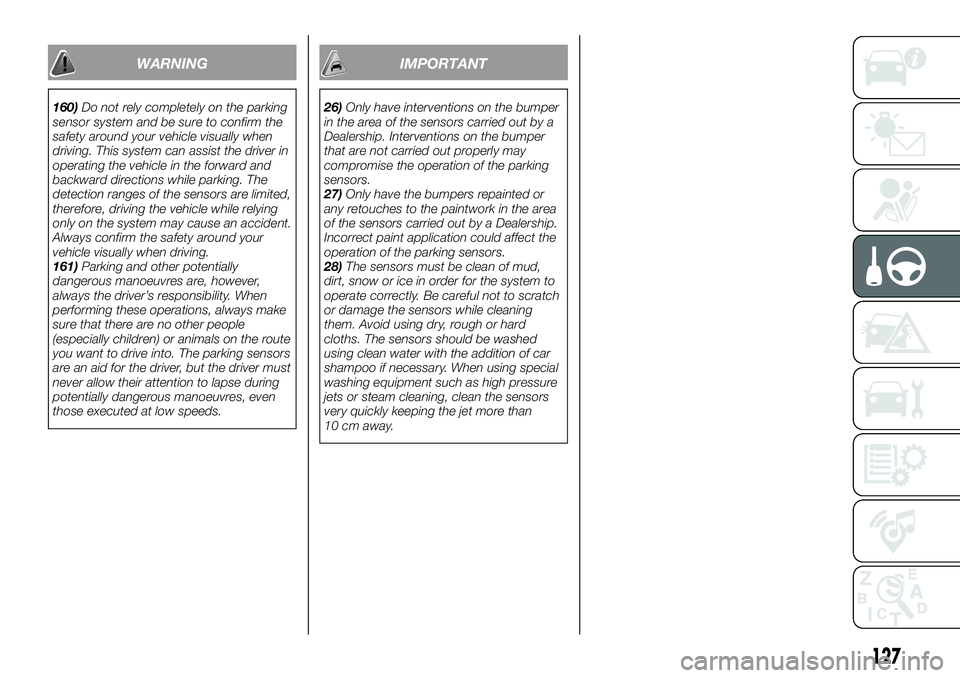
WARNING
160)Do not rely completely on the parking
sensor system and be sure to confirm the
safety around your vehicle visually when
driving. This system can assist the driver in
operating the vehicle in the forward and
backward directions while parking. The
detection ranges of the sensors are limited,
therefore, driving the vehicle while relying
only on the system may cause an accident.
Always confirm the safety around your
vehicle visually when driving.
161)Parking and other potentially
dangerous manoeuvres are, however,
always the driver’s responsibility. When
performing these operations, always make
sure that there are no other people
(especially children) or animals on the route
you want to drive into. The parking sensors
are an aid for the driver, but the driver must
never allow their attention to lapse during
potentially dangerous manoeuvres, even
those executed at low speeds.
IMPORTANT
26)Only have interventions on the bumper
in the area of the sensors carried out by a
Dealership. Interventions on the bumper
that are not carried out properly may
compromise the operation of the parking
sensors.
27)Only have the bumpers repainted or
any retouches to the paintwork in the area
of the sensors carried out by a Dealership.
Incorrect paint application could affect the
operation of the parking sensors.
28)The sensors must be clean of mud,
dirt, snow or ice in order for the system to
operate correctly. Be careful not to scratch
or damage the sensors while cleaning
them. Avoid using dry, rough or hard
cloths. The sensors should be washed
using clean water with the addition of car
shampoo if necessary. When using special
washing equipment such as high pressure
jets or steam cleaning, clean the sensors
very quickly keeping the jet more than
10 cm away.
127
Page 135 of 228
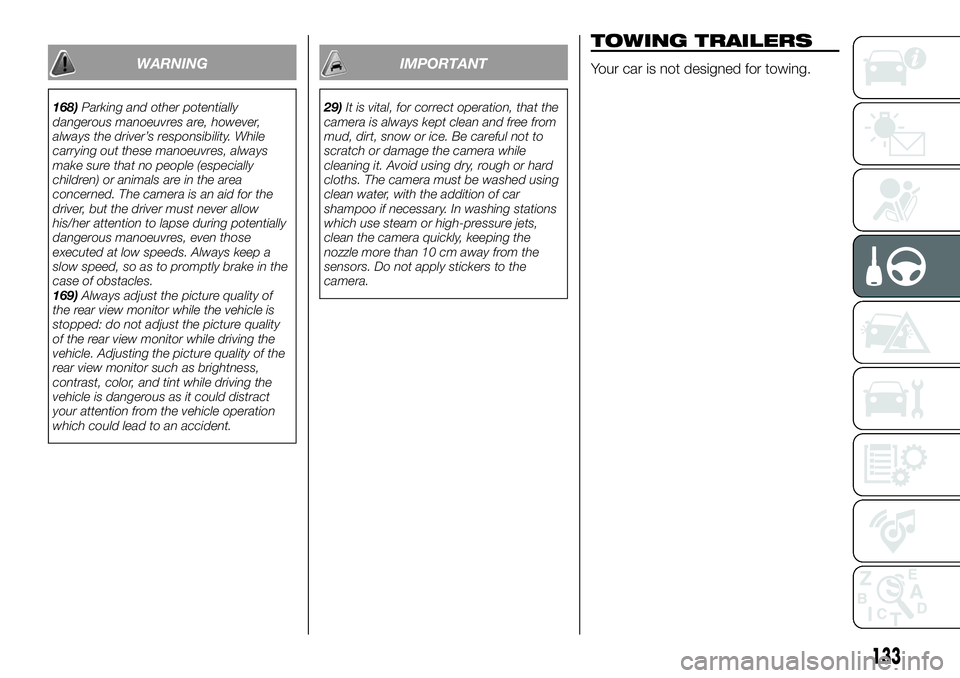
WARNING
168)Parking and other potentially
dangerous manoeuvres are, however,
always the driver’s responsibility. While
carrying out these manoeuvres, always
make sure that no people (especially
children) or animals are in the area
concerned. The camera is an aid for the
driver, but the driver must never allow
his/her attention to lapse during potentially
dangerous manoeuvres, even those
executed at low speeds. Always keep a
slow speed, so as to promptly brake in the
case of obstacles.
169)Always adjust the picture quality of
the rear view monitor while the vehicle is
stopped: do not adjust the picture quality
of the rear view monitor while driving the
vehicle. Adjusting the picture quality of the
rear view monitor such as brightness,
contrast, color, and tint while driving the
vehicle is dangerous as it could distract
your attention from the vehicle operation
which could lead to an accident.
IMPORTANT
29)It is vital, for correct operation, that the
camera is always kept clean and free from
mud, dirt, snow or ice. Be careful not to
scratch or damage the camera while
cleaning it. Avoid using dry, rough or hard
cloths. The camera must be washed using
clean water, with the addition of car
shampoo if necessary. In washing stations
which use steam or high-pressure jets,
clean the camera quickly, keeping the
nozzle more than 10 cm away from the
sensors. Do not apply stickers to the
camera.
TOWING TRAILERS
Your car is not designed for towing.
133
Page 138 of 228
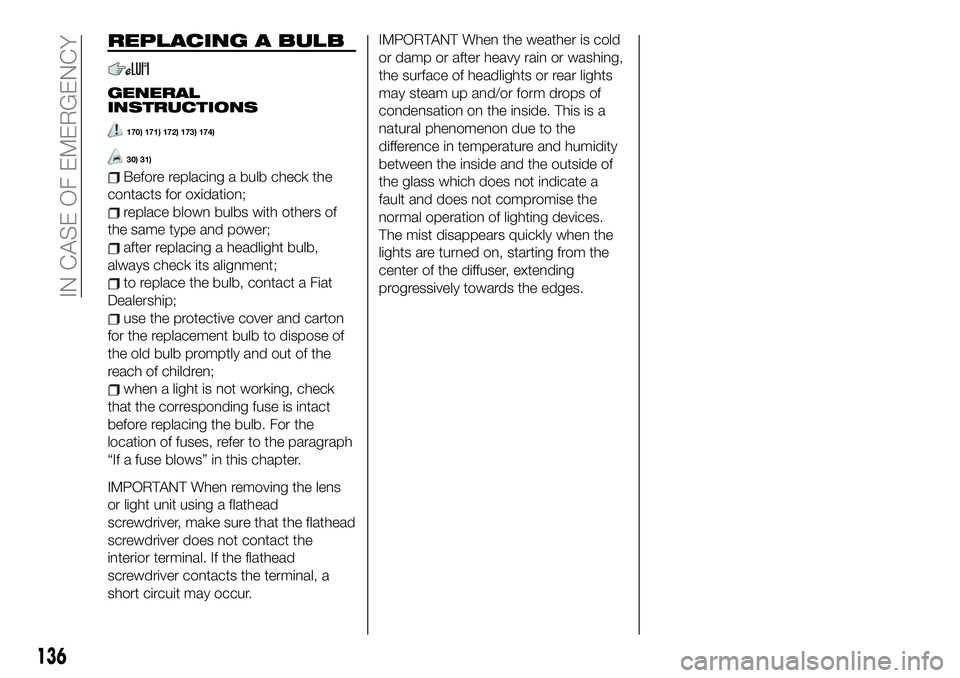
REPLACING A BULB
GENERAL
INSTRUCTIONS
170) 171) 172) 173) 174)
30) 31)
Before replacing a bulb check the
contacts for oxidation;
replace blown bulbs with others of
the same type and power;
after replacing a headlight bulb,
always check its alignment;
to replace the bulb, contact a Fiat
Dealership;
use the protective cover and carton
for the replacement bulb to dispose of
the old bulb promptly and out of the
reach of children;
when a light is not working, check
that the corresponding fuse is intact
before replacing the bulb. For the
location of fuses, refer to the paragraph
“If a fuse blows” in this chapter.
IMPORTANT When removing the lens
or light unit using a flathead
screwdriver, make sure that the flathead
screwdriver does not contact the
interior terminal. If the flathead
screwdriver contacts the terminal, a
short circuit may occur.IMPORTANT When the weather is cold
or damp or after heavy rain or washing,
the surface of headlights or rear lights
may steam up and/or form drops of
condensation on the inside. This is a
natural phenomenon due to the
difference in temperature and humidity
between the inside and the outside of
the glass which does not indicate a
fault and does not compromise the
normal operation of lighting devices.
The mist disappears quickly when the
lights are turned on, starting from the
center of the diffuser, extending
progressively towards the edges.
136
IN CASE OF EMERGENCY
Page 146 of 228

172)Halogen bulbs contain pressurised
gas, in the case of breakage they may
burst causing glass fragments to be
projected outwards.
173)Only replace bulbs when the engine is
off. Also ensure that the engine is cold, to
prevent the risk of burns.
174)Only replace the bulb when the
engine is off and the vehicle is in a safe
position that does not cause danger to the
traffic and allows for a safe replacement
(refer to “Parking” paragraph in “Starting
and operating” chapter). Also ensure that
the engine is cold, to prevent the risk of
burns.
IMPORTANT
30)Where possible, it is advisable to have
bulbs changed at a Fiat Dealership. Proper
operation and direction of the external
lights are essential for driving in safety and
comply with law.
31)Halogen bulbs must be handled
holding the metallic part only. Touching the
transparent part of the bulb with your
fingers may reduce the intensity of the
emitted light and even reduce the lifespan
of the bulb. In the event of accidental
contact, wipe the bulb with a cloth
moistened with alcohol and let the bulb dry
REPLACING FUSES
GENERAL INFORMATION
175) 176) 177) 178) 179)
32) 33)
Fuse location
Fuses are grouped together in two fuse
boxes located on the left side of the
vehicle and under the bonnet.
FUSES ON THE LEFT
SIDE OF THE VEHICLE
Proceed as follows:
make sure the ignition is switched
off, and other switches are off;
open the fuse panel cover
fig. 122 (located near the door);
press retaining clip and remove
protection cover;
pull the fuse straight out with the fuse
puller provided on the fuse block
located in the engine compartment
fig. 123;
inspect the fuse and replace it if it is
blown;
insert a new fuse of the same
amperage rating, and make sure it fits
tightly. If it does not fit tightly, contact a
Fiat Dealership. If you have no spare
fuses, borrow one of the same rating
from a circuit not essential to vehicle
operation, such as the AUDIO or
OUTLET circuit;
reinstall the cover and make sure that
it is securely installed.
IMPORTANT Always replace a fuse with
a genuine FCA fuse or equivalent of the
same rating. Otherwise you may
damage the electric system.12207031601-121-001
12307031601-122-001
144
IN CASE OF EMERGENCY
Page 162 of 228
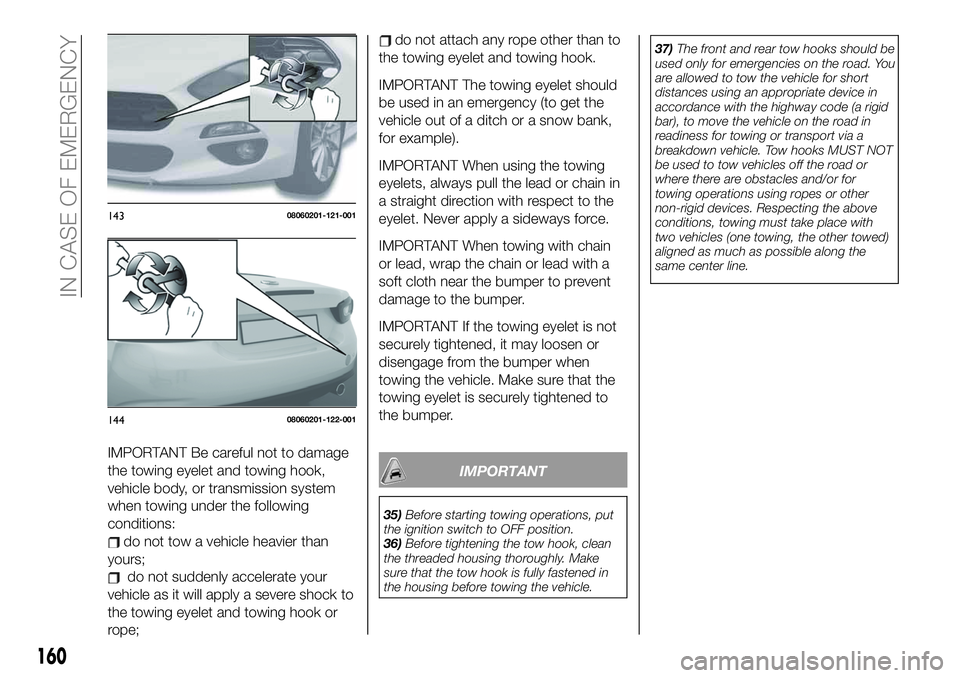
IMPORTANT Be careful not to damage
the towing eyelet and towing hook,
vehicle body, or transmission system
when towing under the following
conditions:
do not tow a vehicle heavier than
yours;
do not suddenly accelerate your
vehicle as it will apply a severe shock to
the towing eyelet and towing hook or
rope;
do not attach any rope other than to
the towing eyelet and towing hook.
IMPORTANT The towing eyelet should
be used in an emergency (to get the
vehicle out of a ditch or a snow bank,
for example).
IMPORTANT When using the towing
eyelets, always pull the lead or chain in
a straight direction with respect to the
eyelet. Never apply a sideways force.
IMPORTANT When towing with chain
or lead, wrap the chain or lead with a
soft cloth near the bumper to prevent
damage to the bumper.
IMPORTANT If the towing eyelet is not
securely tightened, it may loosen or
disengage from the bumper when
towing the vehicle. Make sure that the
towing eyelet is securely tightened to
the bumper.
IMPORTANT
35)Before starting towing operations, put
the ignition switch to OFF position.
36)Before tightening the tow hook, clean
the threaded housing thoroughly. Make
sure that the tow hook is fully fastened in
the housing before towing the vehicle.37)The front and rear tow hooks should be
used only for emergencies on the road. You
are allowed to tow the vehicle for short
distances using an appropriate device in
accordance with the highway code (a rigid
bar), to move the vehicle on the road in
readiness for towing or transport via a
breakdown vehicle. Tow hooks MUST NOT
be used to tow vehicles off the road or
where there are obstacles and/or for
towing operations using ropes or other
non-rigid devices. Respecting the above
conditions, towing must take place with
two vehicles (one towing, the other towed)
aligned as much as possible along the
same center line.
14308060201-121-001
14408060201-122-001
160
IN CASE OF EMERGENCY
Page 165 of 228
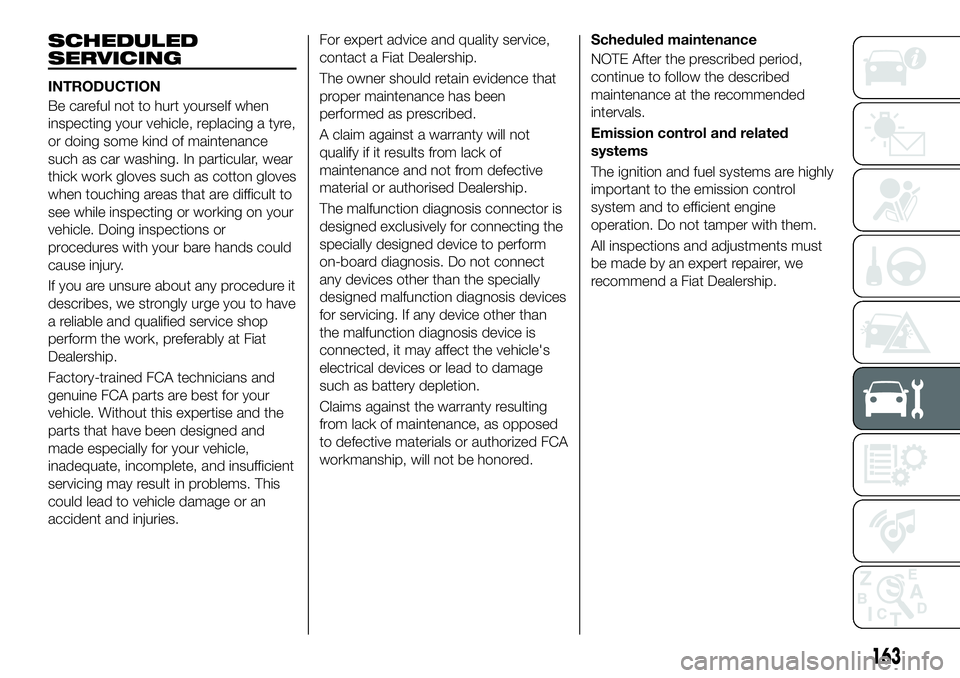
SCHEDULED
SERVICING
INTRODUCTION
Be careful not to hurt yourself when
inspecting your vehicle, replacing a tyre,
or doing some kind of maintenance
such as car washing. In particular, wear
thick work gloves such as cotton gloves
when touching areas that are difficult to
see while inspecting or working on your
vehicle. Doing inspections or
procedures with your bare hands could
cause injury.
If you are unsure about any procedure it
describes, we strongly urge you to have
a reliable and qualified service shop
perform the work, preferably at Fiat
Dealership.
Factory-trained FCA technicians and
genuine FCA parts are best for your
vehicle. Without this expertise and the
parts that have been designed and
made especially for your vehicle,
inadequate, incomplete, and insufficient
servicing may result in problems. This
could lead to vehicle damage or an
accident and injuries.For expert advice and quality service,
contact a Fiat Dealership.
The owner should retain evidence that
proper maintenance has been
performed as prescribed.
A claim against a warranty will not
qualify if it results from lack of
maintenance and not from defective
material or authorised Dealership.
The malfunction diagnosis connector is
designed exclusively for connecting the
specially designed device to perform
on-board diagnosis. Do not connect
any devices other than the specially
designed malfunction diagnosis devices
for servicing. If any device other than
the malfunction diagnosis device is
connected, it may affect the vehicle's
electrical devices or lead to damage
such as battery depletion.
Claims against the warranty resulting
from lack of maintenance, as opposed
to defective materials or authorized FCA
workmanship, will not be honored.Scheduled maintenance
NOTE After the prescribed period,
continue to follow the described
maintenance at the recommended
intervals.
Emission control and related
systems
The ignition and fuel systems are highly
important to the emission control
system and to efficient engine
operation. Do not tamper with them.
All inspections and adjustments must
be made by an expert repairer, we
recommend a Fiat Dealership.
163